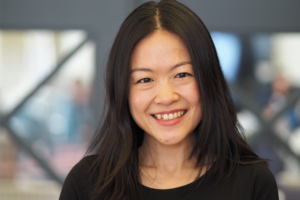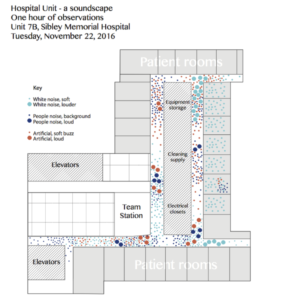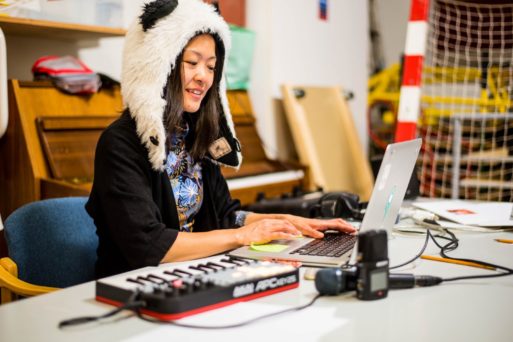Today SevenPonds speaks with Yoko K. Sen, the founder of Sen Sound, a Washington, D.C.-based startup that’s working to transform the experience of hospitalized patients and their families through sound. Ms. Sen is a renowned electronic musician and sound alchemist who has been performing professionally since she was 3 years old. The recipient of the Washington Music Association Award for “Best Electronica Artist,” 2011-2012, she also became the first electronic musician to serve as an artist in residence at Strathmore. Today, her focus is on working to decrease noise pollution in hospitals through human-centered sound design.
 Kathleen: Hi Yoko. Thanks so much for making the time to speak with me. Can you begin by telling me a little about how Sen Sound came about?
Kathleen: Hi Yoko. Thanks so much for making the time to speak with me. Can you begin by telling me a little about how Sen Sound came about?
Yoko Sen: Certainly. Several years ago, I became ill and had to spend a lot of time in the hospital. I’ve been a musician all my life, so I’m very sensitive to sound. And the amount of noise that went on constantly — loud talking, doors slamming, machines beeping — was disturbing and scary to me. It was not a healing environment at all.
When I was better, I decided to explore the idea of transforming hospitals into truly healing spaces through the use of human-centered sound design. I applied for the Halcyon incubator program as a tech startup, and last year I started a residency at Sibley Memorial Hospital’s Innovation Hub. I’ve been collaborating with a team of researchers and designers there ever since.
Kathleen: So this is a relatively new venture?
Yoko: Yes. I’d say we started about two years ago, and really began to get some interest and support in early 2016.

A sound map of hospital noise
Credit: sensound.space
Kathleen: What kind of research have you been doing thus far?
Yoko: Well, as I said, our focus is human-centered design. So, one study we did last summer was to interview patients and staff on one of the units at the hospital and ask them how sound impacts them. We interviewed 40 patients and 10 staff and asked them questions like “What sounds do you find most disturbing?” and “What is your favorite sound”? We also explored people’s relationship with sound. For example, some people love silence and find it relaxing. But some people hate it and actually can’t relax unless there is some sound in the background, like a radio or a TV.
We also employed an acoustic engineer who created a sound map of the unit, which showed us where the most noise occurred and what kind of noise it was.
What did you learn from the patient interviews?
Yoko: Not surprisingly, the patient’s number one complaint was alarms, which are constantly going off all day and all night. But about half of the people we interviewed also said that noises related to human behavior were very disturbing as well. Loud talking and slamming doors were two of their biggest complaints.
Kathleen: Have you been able to begin looking at ways to alleviate some of the most disturbing noises? For example, could the hospital provide staff with some kind of wearable device that could alert them to a patient in distress? Or could it re-engineer the alarms?
Yoko: Actually, we are just starting to work with a device company right now, but because of confidentiality issues I can’t discuss that very much. What I can share, though, is that making these kinds of changes isn’t as easy as you might think. There is actually an international commission that creates standards for hospital alarms. So a hospital can’t just decide to change alarm sounds or do away with certain alarms on its own without losing its accreditation, which no hospital wants to do.

Yoko at work in her studio
Credit: medium.com
Kathleen: I never knew that! So there’s actually a group that designs these alarms and decides how loud and disturbing they need to be?
Yoko: Yes! But the standards they use are old and based on a culture of fear. The idea is that the alarms need to be as annoying as possible to get the attention of the staff. But what actually happens is that there are so many alarms competing with each other that staff develop “alarm fatigue.” They know that 90 percent of the alarms they hear are false alarms anyway, so they become desensitized to them. That’s a very dangerous situation because when a real crisis happens, the staff is less likely to respond.
Kathleen: And you’re working to change that culture?
Yoko: That’s our goal. We have a team of researchers, some of them in the U.S. and some in Europe, working on updating the regulations so that we can begin to implement change. My vision is that 10 years from now we will have hospitals with no sound except the kinds of sound that helps patients heal.
Kathleen: That sounds like a wonderful goal!
This concludes part one of our interview with sound artist Yoko Sen. Please come back next week to read part two. And if you’d like to learn more about Yoko and her team’s research, check out the video below.

 Can Human-Centered Sound Design Transform Hospitals?
Can Human-Centered Sound Design Transform Hospitals?


 First the Wealth Gap, Now the U.S. Has a Growing Health Gap
First the Wealth Gap, Now the U.S. Has a Growing Health Gap

 Our Annual Seven Holiday Gifts for Someone Who Is Grieving, 2024 Edition
Our Annual Seven Holiday Gifts for Someone Who Is Grieving, 2024 Edition














